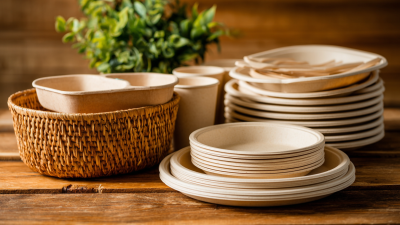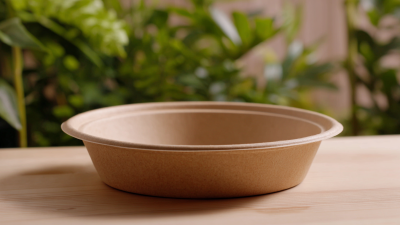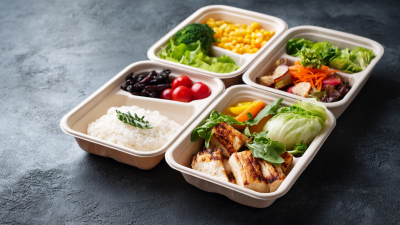In recent years, there has been a growing awareness of environmental issues, prompting consumers and businesses alike to seek sustainable alternatives in various aspects of daily life, including dining. The shift towards more eco-friendly solutions has highlighted the importance of using biodegradable crockery, which presents a viable option for reducing the ecological footprint associated with traditional disposable tableware. Biodegradable crockery not only contributes to waste reduction by breaking down naturally and returning to the earth without leaving harmful residues, but it also maintains the functionality and aesthetic appeal of conventional dinnerware.

By understanding the benefits of incorporating biodegradable crockery into modern dining experiences, we can make more informed choices that align with our values of sustainability and environmental responsibility. This tutorial will explore the various advantages of biodegradable crockery, including its impact on waste management, health benefits, and its role in influencing consumer behavior towards a greener future.
The rise of biodegradable crockery in today's dining experience reflects a significant shift towards more sustainable practices within the food service industry. With the global food service packaging market expected to reach an astounding 812.08 billion yuan by 2024, it is imperative to underscore the growth and importance of biodegradable materials, particularly in the context of increasing public awareness regarding environmental conservation. The pandemic has further emphasized the need for safe and hygienic dining options, propelling the demand for biodegradable products, which can help minimize the environmental impact while ensuring health safety.

As indicated by market analysis, the disposable tableware segment alone is projected to surpass 100 billion yuan by 2025, categorized mainly into biodegradable, photodegradable, and easily recyclable materials. This segmentation highlights a crucial trend: consumers and businesses are increasingly opting for biodegradable options to meet both sustainability goals and health standards. Incorporating biodegradable crockery not only enhances the dining experience but also aligns with the green values embraced by contemporary diners.
Tips: When choosing biodegradable options, look for certifications that guarantee decomposability. Additionally, educate your customers about the benefits of switching to such sustainable alternatives, as their awareness can influence future dining choices. Lastly, consider collaborating with suppliers that focus on eco-friendly materials to strengthen your commitment to sustainability.
In recent years, the environmental concerns surrounding plastic waste have prompted many consumers to seek eco-friendly alternatives in their dining choices. One significant step towards reducing our ecological footprint is the use of biodegradable crockery. These tableware options, made from natural materials like cornstarch, sugarcane, and bamboo, decompose much faster than traditional plastic counterparts, breaking down within months rather than centuries. This means less waste ending up in landfills and oceans, significantly alleviating the pollution crisis that affects our planet.
Choosing biodegradable tableware also supports sustainable practices and encourages responsible consumption. By opting for these products, we're not only minimizing plastic waste but also promoting the use of renewable resources that have a less harmful impact on the environment. Additionally, many biodegradable options are designed to be stylish and functional, allowing modern dining experiences to remain both aesthetically pleasing and environmentally responsible. Making the switch to biodegradable crockery is a simple yet impactful way to contribute to a healthier planet, making it an essential consideration for conscious consumers today.
 Biodegradable crockery is increasingly becoming the preferred choice for modern dining due to its ability to enhance food presentation while being environmentally friendly. Unlike traditional plasticware, biodegradable options made from materials like sugarcane bagasse and bamboo not only add an aesthetic touch but also reflect a commitment to sustainability. These materials can break down within 60 days, reducing waste and contributing to a cleaner planet.
Biodegradable crockery is increasingly becoming the preferred choice for modern dining due to its ability to enhance food presentation while being environmentally friendly. Unlike traditional plasticware, biodegradable options made from materials like sugarcane bagasse and bamboo not only add an aesthetic touch but also reflect a commitment to sustainability. These materials can break down within 60 days, reducing waste and contributing to a cleaner planet.
In addition to their eco-friendly benefits, biodegradable dinnerware can elevate the dining experience. The natural textures and earthy tones of these products complement the visual aspects of food, making dishes more appealing. Furthermore, innovations in biopolymer films and fiber-reinforced structures can lead to the development of utensils and plates that maintain food integrity without sacrificing durability. This fusion of sustainability with culinary art promotes an inviting atmosphere for diners while supporting a shift towards more sustainable dining practices.
In today's environmentally conscious society, the adoption of biodegradable crockery presents an effective cost-saving solution for both consumers and businesses. Biodegradable options not only help in reducing waste but also can significantly decrease expenses related to disposal and environmental compliance. With the growing emphasis on sustainability, companies are increasingly integrating these eco-friendly alternatives into their daily operations, leading to long-term financial benefits and positive brand reputation.
By choosing biodegradable crockery, businesses can align with regulatory demands and contribute to circular economy initiatives. This shift can minimize overhead costs associated with waste management and improve efficiency through the reduction of landfill waste. Moreover, using biodegradable products often opens new avenues for innovation and eco-friendly marketing strategies, attracting customers who prioritize sustainability. Ultimately, embracing biodegradable crockery is not just a responsible choice for the planet; it’s a savvy financial decision that supports a shifting paradigm towards sustainable dining practices.
This chart illustrates the average cost associated with traditional crockery compared to biodegradable options. As shown, biodegradable crockery presents a significant cost-effective solution for modern dining while also offering environmental benefits.
In recent years, there has been a significant shift in consumer behavior towards sustainable dining options. People are increasingly aware of the environmental impact of their choices, leading to a growing demand for biodegradable products. This trend reflects a broader awareness of sustainability issues, as consumers are making informed decisions that align with their values. Many diners now prefer to eat at establishments that offer eco-friendly alternatives, such as biodegradable crockery, which helps to reduce waste and carbon footprints.
Moreover, restaurants and caterers are responding to this shift by incorporating biodegradable crockery into their service. This not only enhances their brand image as environmentally responsible but also attracts a clientele that prioritizes sustainability. By choosing biodegradable options, these businesses demonstrate their commitment to protecting the planet while appealing to modern consumers who are increasingly conscious of their dining habits. As this trend continues to evolve, we can expect to see more innovative solutions in the realm of sustainable dining, reshaping how we think about food consumption and waste.






